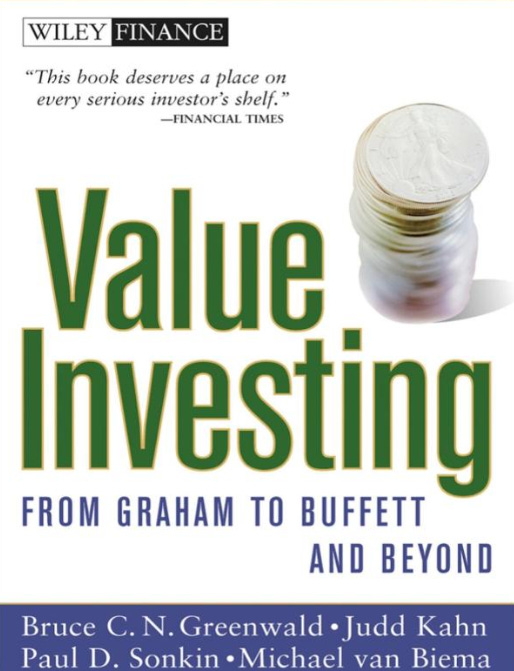Value Investing: From Graham to Buffett and Beyond is one of the seminal books on value investing. In this book, author Bruce C. Greenwald features some of the world's most successful value investors. And he breaks down the methodologies they use to trounce the market.
Spoiler alert: it's more than just looking for cheap stocks and underappreciated asset values on the balance sheet.
Greenwald is just the man to tell us about these value investing principles. He is a professor of Finance and Asset Management at Columbia Business School. And he's also the academic co-director of the Heilbrunn Center for Graham & Dodd Investing.
Through this position, he has taught many successful investors the way value investing. In fact, The New York Times describes him as “a guru to Wall Street’s gurus.”
Any investor looking to dig into the fundamentals of a company should understand these following concepts from the book.
Enduring Value and Competitive Advantage
The concept of competitive advantage is very simple. A company has a sustainable competitive advantage over another firm because it offers customers something better than what the competitor provides. This is true whether the product is tangible, such as a car or a computer, or intangible, like customer service. In either case, the company must offer something unique, superior, or differentiated.
A superior product is on form of competitive advantage Greenwald mentions. And to maintain that advantage, companies need to spend on research and development and advertising. These are necessary expenses and should not be frowned upon.
Another advantage for a company can be due to supply factors. An oil company like Saudi Aramco can sustain high returns on capital because they are swimming in oil that is easy to pump out of the ground. As long as those Ghawar oil field has oil, it will be cheaper for them to produce oil than the deep water drilling rigs off the South Texas Gulf Coast.
Another sustainable advantage can be a lower cost of capital. Companies in more stable political jurisdictions can borrow money from investors for less than companies in less stable countries. This lower cost of capital will help the company expand and continue operations.
In theory, competitive advantage is easy to identify. But in practice, it is often difficult to determine whether a company truly enjoys a competitive advantage. This is especially true in industries where there are many competitors offering similar products or services.
Value investors believe that companies that enjoy a competitive advantage tend to outperform those without one. They base this belief on the fact that most firms do not maintain a competitive advantage indefinitely. Over time, competition erodes a competitive advantage.
For example, General Motors enjoyed a strong position in the automobile industry for decades. Then came Toyota Motor Company, which offered lower prices, greater fuel efficiency, and superior quality vehicles. GM eventually lost market share and went bankrupt.
This is one example of losing a competitive advantage over time.
Current earnings power
Bruce Greenwald's valuation approach is to find the current earnings power value (EPV) of a company and compare it to the net asset value (NAV). To do that he uses the following formula:
Adjusted earnings / costs of capital
He defines adjusted earnings as the sustainable level of cash flows distributable to owners. This formula also assumes that the future cash flows stays the same. In other words the company will have a 0% rate of growth.
That's quite the assumption, but it creates a conservative value to work with.
Greenwald also suggests subtracting the debt and adding cash to that calculation to back out any leverage.
Then to determine the franchise value of the company, he takes the EPV and subtracts the NAV from it. The NAV is just the assets minus liabilities or another number is the tangible book value.
And that's the basis for Greenwald's investment strategy for stock market beating returns.
Price is what you pay, value is what you get
Value investing is a strategy where investors purchase shares they believe are undervalued at current market prices. They compare the current value to the present value of future distributable cash flows. If the stock price is less than the PV of cash flows, you may have a bargain.
And he talks about the "margin of safety" investors like Benjamin Graham and Seth Klarman have popularized. Graham has said that the margin of safety should not be less than 33% of the fundamental value of a company. In other words, if you think the value of a companies shares is $100, you should not pay more than $67 for those shares.
By building in this cushion, you can help protect against a loss of capital.
This framework has set the foundation for investment decisions of value investors over the past few decades. Famed investors like Warren Buffett, Charlie Munger, Mohnish Pabrai, and more.
This summary can't possibly explain all the details Greenwald goes into. More concepts he talks about are the network effects of modern companies, business cycles, and how growth rate impacts valuations. The ability for companies to return excess cash is fundamental in both public and private markets.
Greenwald's Value Investing book comes highly recommended for all barbell investors. To purchase please click here.


